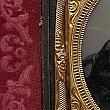
Daguerreians of Grand Rapids
“Grand Rapids’ first photographer dies,” read the 1916 headline announcing the death of Orsamus W. Horton. Originally from western New York, Horton opened his Daguerreian Gallery in August of 1852 on Monroe St. It appears he was a progressive man. Horton is mentioned as the first to add a skylight for photography and is credited as the first in Grand Rapids to print photographs on paper when that process became known. It was Horton who evolved the idea of selling furniture by photograph. He convinced furniture manufacturers to equip their salesmen with a display of photographs of their firms’ products. The 1866 Nelson Matter Co. furniture catalog, one of the earliest, was probably the work of O. W. Horton. While he retired about 1879 he maintained a limited business enlarging and shading photographs. He was a charter member of Fountain St. Baptist Church and lived for many years at the corner of Jefferson and Oakes. In a newspaper interview in 1913, celebrating his ninetieth birthday, Horton recounted that a daguerreotype of John Ball that he made in 1855 was one of his prized possessions. He died three years later at the age of 93 and is buried in Fulton St. Cemetery.
We learn the names and times of arrival of other early daguerreians from Albert Baxter in his 1891 “History of the City of Grand Rapids, Michigan.” Since the earliest came before available newspaper accounts, Baxter is a valuable source for the information about these early photographers. See his “History” for a fuller account of them.
D. Williams arriving in 1846 seems to be truly the first, followed by Adonijah H. Proctor in 1848. A year later S. B. Noble appeared, and about six months later in 1850 C. M. Fox arrived. In July of the same year G. Hanchet succeeded Fox at his location. Also in 1851 Charles F. Moore opened a daguerreian gallery, followed in November by Lorenzo Buell, already a Grand Rapids resident, but formerly a mechanic. A. H. Proctor joined Buell in partnership in June of 1852. A few years later Proctor moved on, Buell was burned out in 1860, and turned his hand to the drug business. If not actually the first, Horton was certainly the most long-standing of the early daguerreians. It was a business that could be set up rather easily, was highly competitive, and consequently sent many on their way to greener pastures or other endeavors.
In 1856 James Minton Keeney arrived in Grand Rapids—no doubt because he had aunts and uncles here—from Rochester, NY where he had operated a daguerreian studio. He purchased Horton's gallery in 1856 and then sold it back to him in 1858. Keeney and Horton are both credited with making the first photographs on paper in Grand Rapids, but the edge goes to Keeney. He took the earliest photograph of a local scene recorded on a glass negative in 1857. We know Keeney printed on paper because his personal album containing close to twenty of his photographs is housed in the GR History and Special Collections Department of the GR Public Library. It includes a self-portrait of Keeney and a photograph of Orsamus W. Horton. Keeney left the city in 1858 and died in 1860 in Tuscaloosa, Alabama from accidental gunshot wounds at age twenty-five. He is buried in Rochester, NY with his parents.
Certainly these early pioneers would be astonished to see how photography has developed since the daguerreotype, a single image process, which required the sitter to remain still for several minutes. Color photography, digital cameras, computer enhancement, to name just a few would seem miraculous.
Baxter, Albert. History of the City of Grand Rapids, Michigan. New York, Grand Rapids: Munsell & Company, 1891.
Portrait and Biography Index, GR History and Special Collections Department, Grand Rapids Public Library.

 facebook
facebook